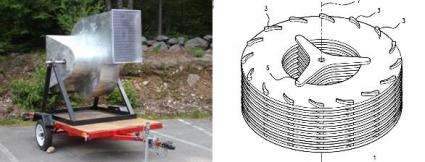May 7, 2010 report
Bladeless wind turbine inspired by Tesla

(PhysOrg.com) -- A bladeless wind turbine whose only rotating component is a turbine/driveshaft could generate power at a cost comparable to coal-fired power plants, according to its developers at Solar Aero. The New Hampshire-based company recently announced its patent on the Fuller wind turbine, which is an improvement on a patent issued to Nikola Tesla in 1913.
The bladeless wind turbine is completely enclosed in a relatively small compact unit. Instead of using wind-powered blades to rotate a shaft and generator, the Tesla-inspired design consists of an array of closely spaced, parallel, thin metal disks separated by spacers. When air flows in the spaces between the disks, the spacers are arranged in such a way as to provide inward momentum to the air, causing the disks to move. The disks are connected to a shaft by spokes, so that the rotating disks cause the shaft to rotate as well. As explained in the patent held by Howard Fuller, the turbine design “provides maximum efficiency in converting wind energy to mechanical power.”
“The turbine of the present invention has the advantage that it is efficient over a wider range of fluid flow rates, as compared with turbines of the prior art, due to the airfoil-shaped spacers,” the patent explains. “This feature makes the present turbine especially useful for generating power from wind, which is inherently random and variable.”
What this efficiency translates to, according to a recent article at EcoGeek, are final costs of about $1.50/watt rated output, which is roughly 2/3 the cost of comparable bladed units. Further, “total operating costs over the lifetime of the unit” are estimated at about $0.12/kWh, which is comparable to current retail electrical rates. The number of disks determines the amount of power that can be produced, and a unit the size of the one pictured should be capable of generating 10kW of power, according to the company.
One major advantage of not having blades is reduced maintenance costs. For instance, the turbines can be mounted on towers or poles, while generator equipment can be located at the tower base, eliminating the need for climbing the tower for routine maintenance. Also, the turbines only need to be mounted high enough to clear nearby obstacles to wind flow. Since there are no external blades that require ground clearance, the tower can likely be shorter than those used for turbines with blades.
Further, the screen-enclosed turbine prevents injuries to birds and bats, avoids the visual pollution of spinning blades, and proper construction can make the turbine nearly transparent to radar microwave emissions, such as those from nearby defense facilities. Due to its reduced maintenance costs and limited infrastructure requirements, the turbine could even be located on urban rooftops.
Besides wind, the turbine’s design also makes it adaptable for geothermal applications, in which a heated fluid is used to drive the turbine. Since the turbine works even with relatively cool fluid, the invention could be particularly useful for situations where the geothermal source does not provide enough heat to produce the “superheated” steam needed to drive a conventional steam engine.
• PhysOrg.com iPhone Apps
• PhysOrg.com Audio Podcasts / iTunes
• Join PhysOrg.com on Facebook!
• Follow PhysOrg.com on Twitter!
More information:
Wind turbine for generation of electric power: U.S. Patent No. 7,695,242
SolarAero.org
via: EcoGeek.org
© 2010 PhysOrg.com
















